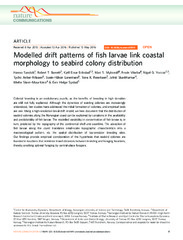Modelled drift patterns of fish larvae link coastal morphology to seabird colony distribution
Permanent lenke
https://hdl.handle.net/10037/9642Dato
2016-05-13Type
Journal articleTidsskriftartikkel
Peer reviewed
Forfatter
Sandvik, Hanno; Barrett, Robert T.; Erikstad, Kjell E; Myksvoll, Mari Skuggedal; Vikebø, Frode Bendiksen; Yoccoz, Nigel Gilles; Anker-Nilssen, Tycho; Lorentsen, Svein-Håkon; Reiertsen, Tone; Skardhamar, Jofrid; Skern-Mauritzen, Mette; Systad, Geir HelgeSammendrag
Colonial breeding is an evolutionary puzzle, as the benefits of breeding in high densities are still not fully explained. Although the dynamics of existing colonies are increasingly understood, few studies have addressed the initial formation of colonies, and empirical tests are rare. Using a high-resolution larval drift model, we here document that the distribution of seabird colonies along the Norwegian coast can be explained by variations in the availability and predictability of fish larvae. The modelled variability in concentration of fish larvae is, in turn, predicted by the topography of the continental shelf and coastline. The advection of fish larvae along the coast translates small-scale topographic characteristics into a macroecological pattern, viz. the spatial distribution of top-predator breeding sites. Our findings provide empirical corroboration of the hypothesis that seabird colonies are founded in locations that minimize travel distances between breeding and foraging locations, thereby enabling optimal foraging by central-place foragers.
Beskrivelse
Publisher's version, source: http://doi.org/doi:10.1038/ncomms11599.


 English
English norsk
norsk